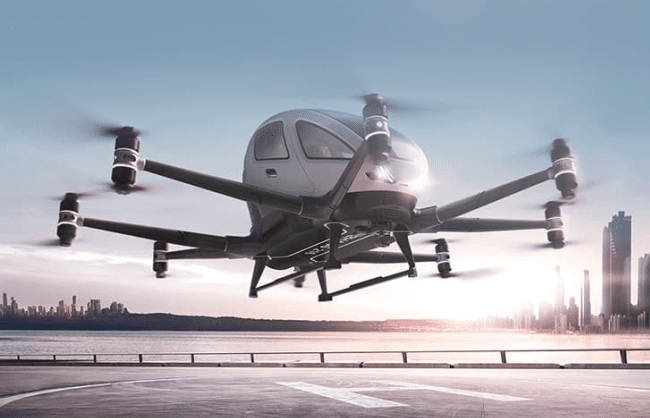Ehang 184

The Guangzhou, China drone company Ehang, Inc. turned a lot of heads at Las Vegas’ 2016 CES (Consumer Electronics Show). With its single-passenger Ehang 184 AAV (autonomous aerial vehicle) on display, the company stirred up a lot of buzz around the future of drone technology and more importantly, whether or not international flight authorities would even allow this drone airborne.
Ehang’s “Personal Flying Machine”
With GoPro’s recent launch of Karma (https://shop.gopro.com/karma) and companies like Amazon and Google developing their own drone versions, there seems to be a technology race (similar to the race to the moon) to launch “THE” drone that consumers can’t wait to get their hands on.
None of these companies, however, have taken the drone leap of faith into the “personal flying machine” zone. Ehang, Inc. took this challenge and has officially begun promoting its 182 horsepower short-to-medium distance autonomous flying drone. The numbers “182” stand for: (1) passenger, (8) propellers, and (4) wings. The Ehang 184 is eco-friendly (running on electricity) and has a flight distance of approximately 23 minutes at sea level.
Limited to a maximum altitude of 11,480 feet, the drone’s cruising speed is approximately 62 mph. The drone is able to carry a passenger weighing up to 264 lbs.
Outside of the air conditioning unit and a reading lamp, the most noteworthy amenity is the drone’s downward facing camera. It captures all the action below throughout your less-than-23-minute-flight.
For People with No Flying Experience
So who is the target consumer for Ehang’s 184? According to an interview with Wired, CFO Shang Hsiao said, “the drone is designed for people with no flying experience – if you have a smartphone app, you can get this up in the air.”
After setting origin (take off) and destination (landing) points using Google Maps, the drone is fully-operational and requires no more assistance. Once the course is set, the drone takes off vertically and uses real-time sensor data (GPS) to fly the passenger to their final destination all while avoiding objects like skyscrapers and cliffs.
That seems to be a rather important detail and begs the question: how does one prevent nose-diving into rush hour traffic if the drone suddenly loses power? According to Ehang Inc., there are multiple power systems, so if one fails, the drone can tap into other power sources.
There are failsafe features alerting human pilots housed in custom-built “command centers” to take over the drone and fly it to the nearest safe zone. Have any of these command centers been built or pilots trained? More on that to come.
Is it Legal?
With its eco-friendly energy source, inverted u-shape flight pattern, and consumer-app-controlled take-offs/landings, the Ehang 184 can only be described as a technological marvel. It’s like looking into the future of drones.
But in my opinion, this is a situation where the cart is way ahead of the horse, innovation-wise. The company has yet to obtain certification or approval from any international flight authority, including its home country of China.
Designed for people with no flight experience, controlled by an App, maximum 23 minutes of flight time, and only 11,400 feet above major cities – all spells out one thing: D-I-S-A-S-T-E-R.
The Ehang 184 drone is not coming to the U.S. anytime soon, especially not in the next 3-4 months. There is no doubt that the U.S. FAA and the Department of Homeland Security will not permit one-person drones flying over any major city.
During the Wired interview Hsiao, when questioned about certification roadblocks said, “Because the 184 AAV represents an entirely new category of technology, there are regulations and agencies that are still catching up. We are in uncharted waters and are working closely with government agencies across the planet to develop and regulate the future of transportation.”
In closing, the Ehang 184 may be the “next-best-thing” in drone technology but make no mistake, this product won’t get regulatory approval for quite some time.
- 100% Green Technology
- Fail-Safe System (Multiple Power Systems)
- Flight Controlled with App (Google Maps)
- Not Certified by International Flight Authorities
- 23-Minute Flight Time (Battery Limit)
- Still not available to consumers



